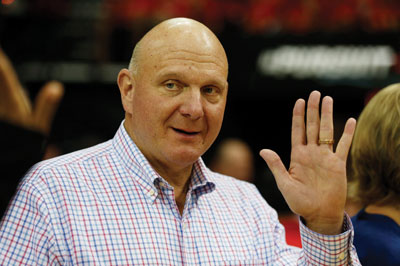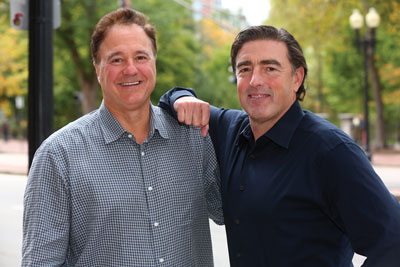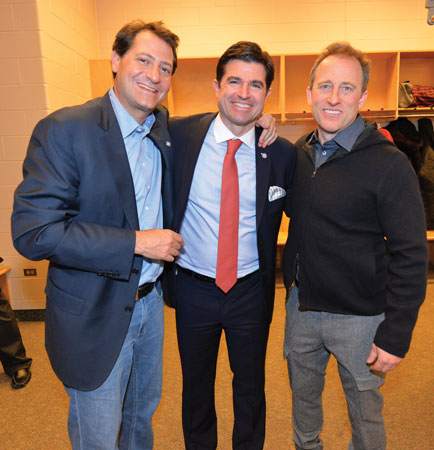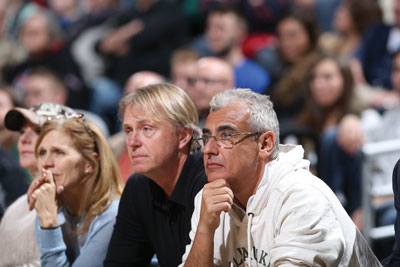There’s a chef carving turkey at the Bridge Club, just steps from the court inside Oracle Arena, and servers pour all the Dehlinger chardonnay and Radio-Coteau pinot noir you want to drink. When the Golden State Warriors leave their locker room, you can watch through one-way glass as they run down the corridor.
Mark Stevens owns less than 10 percent of the Warriors, but like every other investor, the former partner at Sequoia Capital is invited to the party. Before a recent game against the Memphis Grizzlies, he fills a plate, fills a glass and wanders around greeting the other owners and their guests.
“It’s a fun investment, a social investment, because my wife and I know most of the people in the room,” Stevens says.
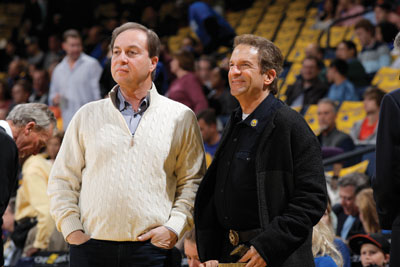 |
Joe Lacob (left), with fellow Warriors owner Peter Guber, sees sports ownership moving toward the Silicon Valley model.
Photo by: NBAE / GETTY IMAGES
|
In that sense, he isn’t so different than the limited partners who owned bits of big league teams a generation ago. Like Stevens, they were usually businessmen who had made money, liked sports and wanted to be in on the fun. A $1 million investment, or even less than that, let them boast that they had part of a franchise.
But look closer. These aren’t local car dealers and plastic surgeons sipping the Dehlinger in the Bridge Club, a space that previously served as a private enclave for former Warriors owner Chris Cohan.
Instead, Stevens is hobnobbing with many of Silicon Valley’s bold-faced names. He greets Dennis Wong, Steve Ballmer’s college roommate, who serves as managing director of SPI Holdings investment firm, and John Walecka, who founded Redpoint Ventures. He introduces a friend to YouTube’s Chad Hurley and former biotech executive Marty Glick. “There are a lot of successful people in this room,” Stevens says. “These guys are doing this for fun, but they are also doing it to have a return on their capital.”
The capital that most of these limited partners have invested in the team runs to many millions of dollars, which is the biggest difference from a generation ago. “It used to be, you could throw in a few bucks and have some fun,” said one sports banker who has represented both buyers and sellers in recent franchise transactions. “Now, to be a limited partner in a league like the NBA that limits the number of total investors a team can have, even the minimum [investment] is quite a big number.”
The jump in franchise valuations has changed the nature of investors and their expectations. With so much money involved, few are content to sit on the sideline without input. And that, by extension, has started to change the executive structure and decision-making process of some franchises.
“It’s happening by necessity because the numbers are just flat-out bigger,” says Joe Lacob, the former Kleiner Perkins executive who serves as the Warriors’ general partner. “It’s moving toward the style of doing business in Silicon Valley, the way investors interact. It’s far more open. It’s very different than the old model of one guy saying ‘I’m doing this, I’m doing that.’”
Stevens, who invested around $50 million in the Warriors, was at Sequoia when the firm invested in Google, and Yahoo, and YouTube. He helped make the decision to put venture capital money in Nvidia and Pixelworks. He has a strong sense of how a viable company should be structured.
“The days when you have one owner who’s an autocrat and makes all decisions down to the color of the underwear are going fast,” he says. “That’s just not a smart way to do it.
“This team,” he says approvingly, “is being run like a real business.”
■ ■ ■ ■
In 1991, billionaire P. Robert Tisch spent $75 million to acquire half of the NFL’s New York Giants. He had no interest in running the team. His expectations of a return were so low as to be nonexistent. “I just want to be able to go to practice on Tuesday and watch from the sideline,” he said a few years after the deal. “I’m going to pretend I never even had that money.”
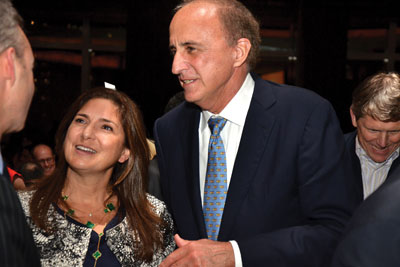 |
Giants minority owner John Scully, with wife Regina, sees owner demographics changing.
Photo by: GETTY IMAGES
|
It made sense. In those days, sports teams were precarious investments. Franchises occasionally went bankrupt. Entire leagues folded. That wasn’t going to happen to the Giants or the NFL, of course — but such uncertainty across the industry exerted a downward pressure on values.
“If you go back 20 years, teams weren’t that expensive,” said Randy Vataha of Game Plan, which helps match potential investors in sports teams with available equity. “People took on a few partners who were friends and family: ‘If I ever buy a team, would you want to be part of it?’ That kind of thing.”
Today, even potentially bankrupt teams are propped up by leagues, which won’t let a franchise fail. The ability to provide predictable programming that comes with a devout viewership has sent TV rights soaring. And what used to be a frivolous way for a successful businessman to enjoy his money has emerged as a prudent investment.
“These are now stable businesses,” said Steve Horowitz, a partner at Inner Circle Sports who recently helped Bruce Levenson sell the Atlanta Hawks and is actively engaged helping NHL, NBA and MLS teams find investors, “businesses being bought by increasingly sophisticated people with a lot of money who see the financial returns ahead.”
It would have seemed implausible back then, but sports has an enviable track record. According to Lacob, franchise valuations have produced an astounding 13 percent annual return over the past few decades. And that figure isn’t skewed by a handful of disproportionate successes. Sports teams in markets big and small have become safe places to park money.
“It used to be ‘How do you become a millionaire? Become a billionaire and buy a sports team,’” said the sports banker who asked not to be identified. “With the changes in the CBAs and the stability you have, that day is long gone.”

Added Vataha, “A guy who might have said, ‘I’m a fan, but I’d rather just buy a suite’ 10 years ago is now saying ‘I can use this in my portfolio.’”
In the 1990s, Boston-based Vataha notes, high-tech companies such as Wang Laboratories fueled the local economy. “All those companies are gone,” he said. “As you look around the world, with technology changing so quickly and institutions we’ve revered for so long being replaced, it’s hard to know what will retain its value. But the Red Sox are still there, and the Bruins and Celtics and Patriots. You can’t displace them.”
That rise in valuations has also served to narrow the pool of possible owners. “The guys like Ballmer who can write a check to do this, there aren’t too many of those,” said John Scully, a venture capitalist in the telecommunications industry who has a piece of the San Francisco Giants. “When I bought in 1999, we were valuing the Giants at $190 million. With the Clippers [who sold for $2 billion last year] and the cable networks producing so much money, I believe the Giants are now worth $2 billion.”
Five percent of $2 billion is $100 million. At that price, it’s no surprise that potential investors are insisting on competent corporate governance. “They’re used to having boards of directors that matter,” Stevens said. “They’re used to crisp decision-making. They’re used to environments in which inputs are taken, things are evaluated, and then you make the right decision with the best available facts. That’s what they’re going to expect.”
■ ■ ■ ■
Stevens wasn’t looking to get rich by investing in the Warriors. He was already rich. But he was in his 50s, had teenagers at home and wanted to keep his wealth intact. Working at a rival VC firm, he had known Lacob for years. They had even played in a pickup game together at the Decathlon Club in Santa Clara in their 20s.
In 2010, when Lacob and Peter Guber’s group paid $450 million for the Warriors, a team with one championship in half a century and that played in a fading arena in a downtrodden city, Stevens thought they were nuts. But by the time Vivek Ranadivé’s minority share became available when Ranadivé became the general partner of the Sacramento Kings three years later, Stevens was ready to look more closely. When he did, he liked what he saw.
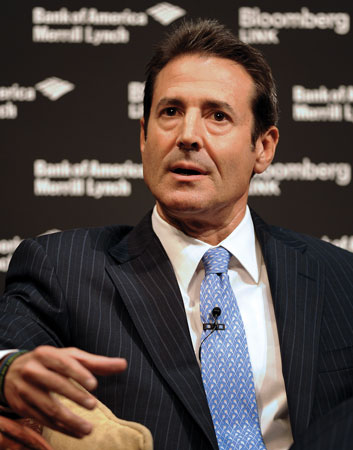 |
“The folks who are able to buy 2 percent, 5 percent or 10 percent of teams are typically … financially sophisticated.” — Charles Baker, ports M&A attorney, DLA Piper
Photo by: GETTY IMAGES
|
“You know your player costs,” he said of the business model. “You know your television revenue. You have a good sense of your merchandise sales. It’s a fairly predictable business, so the vast majority of teams should be profitable if they’re managed correctly. You should be able to deliver a great product to the fans and a profitable enterprise to the shareholders.”
The money Stevens invested got him far less than 10 percent of the Warriors, who were valued at $800 million in 2013, when Ranadivé sold his stake in the club. Until recently, that small slice of ownership would entitle him to little more than good tickets, a discount at the team store, a gem-studded ring if the team won a championship, and a nod from the majority owner when they passed in the hall.
Stevens loves basketball. He grew up rooting for the Lakers of Wilt and Kareem in Los Angeles. He played at Culver City High School, then in regular pickup games as an adult. He has coached his daughter’s team. But as much as he enjoys the sport, under those auspices, he wouldn’t have written the check — “not if the team was owned by a single guy who was domineering and didn’t have a culture of delegating responsibility and trust and transparency,” he said.
Even for the very rich, it seems, $50 million is a lot of money. “The folks who are able to buy 2 percent, 5 percent or 10 percent of teams are typically high net-worth individuals who are financially sophisticated,” said sports M&A attorney Charles Baker, who leads the practice at DLA Piper. “When they’re making their investment, in addition to those perks they’ve always asked for, they may ask for things like a seat on the executive committee, review of the operating budget, even a veto or consent right over certain ancillary and affiliate transactions.”

Yet sports leagues demand that each franchise be constructed in such a way that the largest shareholder can make decisions unimpeded by dissenting opinions. That means a majority owner seeking limited partners must walk a fine line. He needs to offer the place at the conference table that these successful businessmen are accustomed to getting, but he isn’t allowed to cede any real authority.
Perhaps nobody has done it better than Lacob. A former minority investor with the Celtics, he understands what it feels like to have a skin in the game but little say on how it will be played. And after spending his career in Silicon Valley, he feels comfortable running a company collegially, getting suggestions and expertise from multiple sources.
“We have many ways to make sure our partners feel that they have not only a financial involvement, but an emotional one,” Lacob said. Those include monthly conference calls, an annual poker tournament with players and coaches, and the existence of the Bridge Club to foment a “social network,” in Lacob’s words, that allows limited partners to interact both personally and professionally.
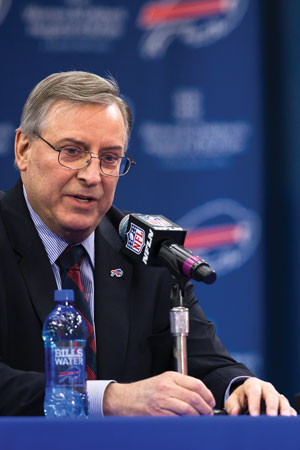 |
The multiple-partner model hasn’t pushed the old ownership model aside. The Bills’ Terry Pegula (top) and the Clippers’ Steve Ballmer are among recent arrivals in the ownership circle who are handling things on their own.
Photos: GETTY IMAGES
|
But the crucial element involves tapping into their expertise. It’s no accident that Lacob has surrounded himself with venture capitalists and digital executives whose skill sets complement his. “To be successful going forward, this needs to be a media company, a real estate company,” he said. “It’s technology, streaming video, all that. It’s the entertainment face beyond having just the game itself. We’ve got to figure out how to monetize that, and the people in our ownership group have the expertise to do that.”
When Lacob goes to NBA meetings these days, he says he looks around the room and still sees some dinosaurs. “There’s a very big difference in terms of how some of these guys run their teams,” he said. “The old autocratic model, I don’t think that works too well. Could I have gone and bought the Warriors by myself? Yes, I could afford that. Or just with Peter. But we recognized it made more sense to do it with other people.”
But not everybody is so sure. George Postolos, the former president of both Houston’s Rockets and Astros who now advises buyers and sellers in sports acquisitions at his own Postolos Group, thinks the higher valuations will attract passive investors enticed purely by the financial play. He sees no shortage of individuals with
stratospheric bank accounts willing to take a Ballmer-sized leap.
“The Clippers have a single owner,” Postolos said. “The [Buffalo] Bills have a single owner. The Astros have multiple investors with one strong controlling owner. The [Chicago] Cubs are owned by a single family. There is no trend towards shared responsibility.” He allows for the possibilities of exceptions on the Lacob model. “But the norm,” he said, “will continue to be a single controlling owner.”
A limited partner in a pro team on the East Coast agrees. “The dollars have ballooned up, but does that really change the dynamic in terms of the relationship between the lead partner and the minority partners? I’m not certain it does,” said this partner, who asked for anonymity — speaking to the sensitivity of the subject in some circles. “Someone paying $30 [million] to $50 million: That’s a lot of money, but it’s still only 3 to 5 percent of a team. So there’s another guy with a whole lot more money involved, and it has been shown pretty clearly that you can’t run one of these things by committee. Every time it has been tried, it has been a train wreck.”
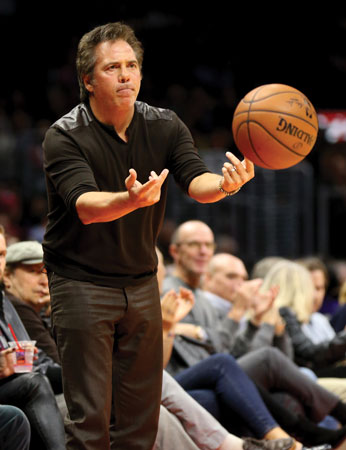 |
Sports ownership increasingly draws from finance (from top): the Pistons’ Tom Gores, the Celtics Steve Pagliuca and Wyc Grousbeck, the 76ers’ David Blitzer and Josh Harris (with Scott O’Neil) and the Bucks’ Wes Edens and Marc Lasry.
Photos by: GETTY IMAGES (2); NBAE / GETTY IMAGES (2)
|
Still, if the latest round of franchise transactions are any guide, many of those who find the sector compelling enough to invest in it as general partners have private equity backgrounds. In the NBA alone, the Celtics, Bucks, Pistons, 76ers, Warriors and Hawks serve as examples. (“You’ll find them all over the place in recent deals,” Baker said.) Most observers around the financial side of sports believe that having owners with that background will inevitably lead to franchises that resemble the companies they’ve spent their business careers investing in and running.
“The ownership demographics have changed and will continue to change dramatically,” Scully said. “Value wins out. We’ve got some huge egos in the business right now, but you’ll see fewer and fewer of those iconoclastic, ego-driven characters in the future. The valuations, the amount of money involved — they’re just too high for that.”
■ ■ ■ ■
To Stevens, the Warriors are more than a sports team.
They’re a real estate play and a digital media investment, with increasing international exposure over time. “You’re investing in a whole portfolio of assets,” he says. “That’s what makes it even more appealing than a hotel or a winery or a hot startup in Silicon Valley.”
And there’s the basketball. Stevens has seats directly on the court, right across from the Warriors bench. Hurley is behind him in the second row, Guber and Lacob a few
seats down. As he watches his team play Memphis, Stevens has the perspective of someone firmly on the inside. “That’s a player who won’t be back next season, I can tell you that,” he says about one underachiever.
More than anything, he’s a fan. When Klay Thompson buries a third consecutive 3-pointer, Stevens turns and gives Hurley a handslap as fierce as any in the building. It isn’t because winning this game, or even the NBA title, will have measurable influence on the value of his equity. Rather, it’s the sense they share of having a seat on a bus that’s heading somewhere special: to the NBA Finals, perhaps, and eventually a new arena near the
San Francisco waterfront, and greater profitability brought about by a widening range of revenue streams.
As someone who has made his career investing in companies run by entrepreneurs he believes in, Stevens knows he doesn’t need to be driving that bus. But it’s sure nice to have a seat in the front row.
Bruce Schoenfeld is a writer in Colorado. He can be reached at bruce@bruceschoenfeld.com.








